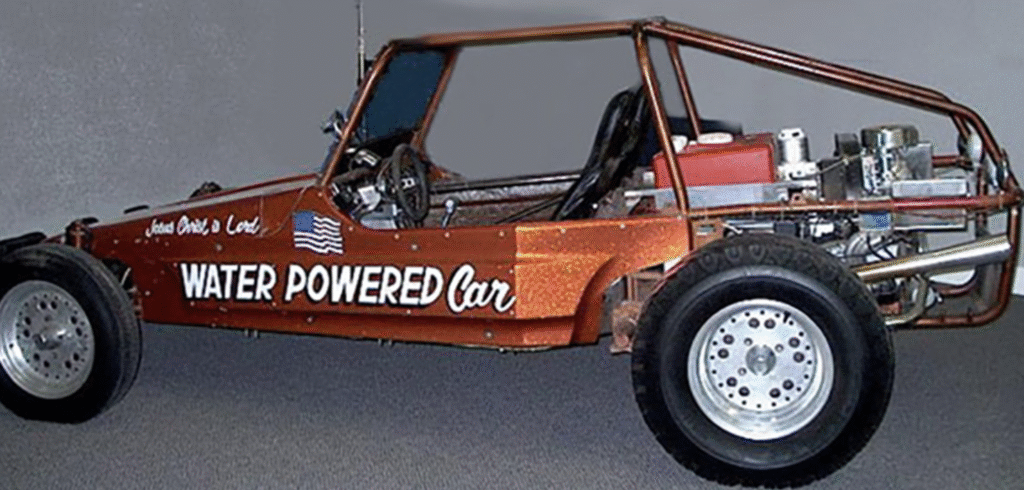More than three decades ago, Stanley Meyer, an American inventor, claimed to have developed a groundbreaking technology that could power vehicles using only water. His “water fuel cell” promised to revolutionize the automotive industry by eliminating reliance on fossil fuels, offering a clean, abundant, and sustainable energy source. However, Meyer’s sudden death in 1998, under mysterious circumstances, sparked widespread speculation and conspiracy theories, with many believing he was murdered to suppress his invention. This article explores Meyer’s life, his controversial water fuel cell, the scientific skepticism surrounding it, and the enigmatic events of his death.
Stanley Meyer: The Inventor
Stanley Allen Meyer was born on August 24, 1940, in Ohio, USA. A tinkerer from a young age, Meyer developed a keen interest in electronics and engineering. While he lacked formal scientific credentials, his passion for innovation led him to file numerous patents across various fields, including electronic banking and heart monitoring. By the 1980s, Meyer turned his focus to alternative energy, motivated by the 1973 Arab Oil Embargo, which had caused fuel shortages and soaring gas prices in the United States. His most ambitious project was the water fuel cell, which he claimed could split water into hydrogen and oxygen to power a vehicle efficiently.
The Water Fuel Cell: A Game-Changer or a Myth?
Meyer’s water fuel cell was designed to use electrolysis to break water (H₂O) into its constituent elements—hydrogen and oxygen. The hydrogen would then be burned as fuel in a modified internal combustion engine, with oxygen and water vapor as the only emissions. Unlike conventional electrolysis, which requires significant energy input, Meyer claimed his device used a unique “electrical resonance” process that consumed less energy than it produced, defying established scientific principles. He demonstrated his invention using a dune buggy, boldly painted with the words “water powered car” and a reference to his Christian faith, claiming it could travel from Los Angeles to New York on just 22 gallons of water.
The implications of such a technology were staggering. If viable, it could have dismantled the global oil industry, reduced carbon emissions to zero, and made energy virtually free by using water—an abundant resource. Meyer’s dune buggy attracted media attention, including a 1995 BBC documentary, It Runs on Water, narrated by Arthur C. Clarke, which showcased his claims. However, the scientific community was deeply skeptical.
Scientific Scrutiny and Legal Troubles
The core issue with Meyer’s water fuel cell was its apparent violation of the laws of thermodynamics, specifically the first and second laws, which state that energy cannot be created or destroyed, and that energy transformations always involve some loss. Electrolysis, the process of splitting water, requires more energy than is released when the resulting hydrogen is burned. Meyer’s claim of achieving this with minimal energy input suggested a perpetual motion machine, a concept dismissed as impossible by mainstream science. Philip Ball, writing in Nature, called water as a fuel source a “long-running myth,” noting that water is already a “spent fuel” and cannot be burned.
In 1996, Meyer faced legal challenges when two investors, who had purchased dealership rights for his water fuel cell technology, sued him for fraud. The case went to court in Ohio, where Meyer’s dune buggy was to be examined by Michael Laughton, a professor of electrical engineering at Queen Mary University of London. Meyer refused to allow the test, citing a “lame excuse,” according to Laughton. Three court-appointed expert witnesses analyzed the device and concluded it was merely using conventional electrolysis, with no revolutionary properties. The court ruled Meyer’s claims fraudulent, labeling his actions as “gross and egregious fraud” and ordering him to repay $25,000 to the investors. This ruling significantly damaged his credibility.
Despite the setback, Meyer maintained that his technology was legitimate and accused the oil industry and possibly the U.S. government of orchestrating efforts to discredit him. He claimed to have received threats from oil company representatives and lucrative buyout offers to shelve his invention, which he refused.
The Mysterious Death of Stanley Meyer
On March 20, 1998, Meyer’s life came to an abrupt end at a Cracker Barrel restaurant in Grove City, Ohio. He was dining with his brother, Stephen Meyer, and two Belgian investors, reportedly discussing funding for his water fuel cell. After taking a sip of cranberry juice, Meyer clutched his neck, ran outside, and collapsed, allegedly saying, “They poisoned me,” as his final words. He died at the scene at age 57. The official coroner’s report, supported by a three-month police investigation, concluded that Meyer died of a cerebral aneurysm caused by chronic high blood pressure. No traces of poison were found in the toxicology report.
However, the dramatic circumstances of his death—combined with his dying declaration—fueled speculation of foul play. Meyer’s brother, Stephen, and supporters believed he was assassinated to suppress his invention, which posed a threat to the multi-billion-dollar oil industry. Stephen noted the lack of condolences or questions from the Belgian investors present that day, stating, “I never, ever had a trust of those two men ever again.” Conspiracy theories pointed to oil companies, car manufacturers, or even government agencies as potential culprits. Some reports claimed Meyer’s dune buggy and experimental equipment were stolen a week after his death, though it was later rumored to have resurfaced in Canada with the Holbrook family, former associates of Meyer. No definitive evidence supports these claims.
Philippe Vandemoortele, one of the Belgian investors, denied any involvement, stating he had supported Meyer financially for years and considered him a close friend. The lack of concrete evidence of poisoning or foul play led authorities to close the case as a natural death. Still, the absence of Meyer’s working prototype and the expired status of his patents (now in the public domain) have left many questions unanswered.
Legacy and Ongoing Debate
Stanley Meyer’s water fuel cell remains a polarizing topic. Supporters argue he was a visionary silenced by powerful interests, pointing to his patents and media demonstrations as evidence of a suppressed breakthrough. Critics, including most scientists, maintain that his invention was scientifically impossible, citing the thermodynamic constraints and the court’s fraud ruling. No manufacturer has successfully replicated Meyer’s technology, and modern hydrogen fuel cell vehicles, like the Toyota Mirai and Honda Clarity, rely on stored hydrogen rather than on-demand electrolysis from water, requiring significant energy inputs and infrastructure.
Meyer’s story continues to inspire alternative energy enthusiasts. His patents, now freely available, have prompted hobbyists and inventors to explore water-based energy solutions, though none have achieved practical success. James Robey, an advocate for Meyer, established the Kentucky Water Fuel Museum to honor his legacy, lamenting that Meyer’s hometown failed to recognize him with even a plaque. Meanwhile, the rise of electric and hydrogen fuel cell vehicles reflects a shift toward sustainable transport, echoing Meyer’s vision, albeit through different technologies.
Conclusion
Stanley Meyer’s water fuel cell promised a future free from fossil fuels, but its scientific implausibility and his untimely death have left it as a footnote in the history of alternative energy. Whether he was a fraud, a visionary, or a victim of conspiracy remains a matter of debate. His story underscores the tension between innovation and skepticism, as well as the allure of revolutionary ideas in the face of established scientific principles. While the truth behind Meyer’s death and his invention may never be fully resolved, his legacy endures as a symbol of the quest for sustainable energy and the mysteries that sometimes accompany it.



